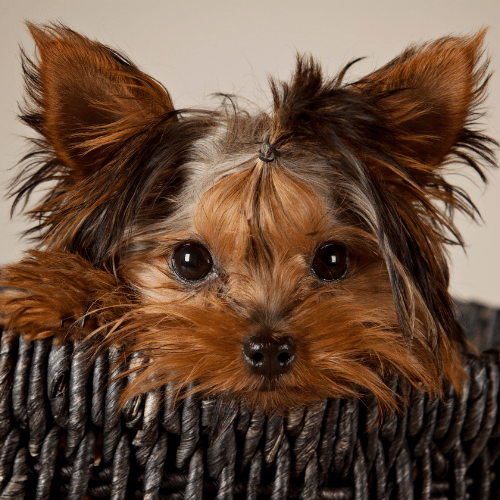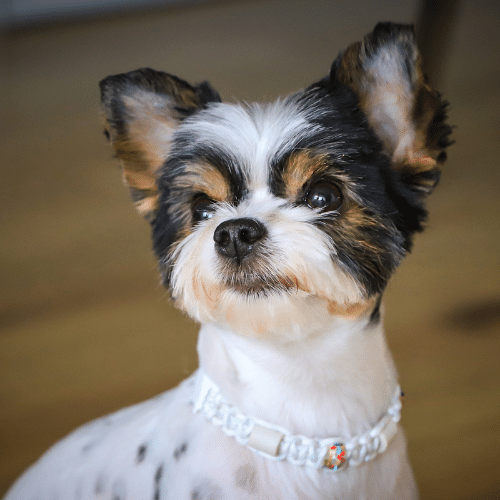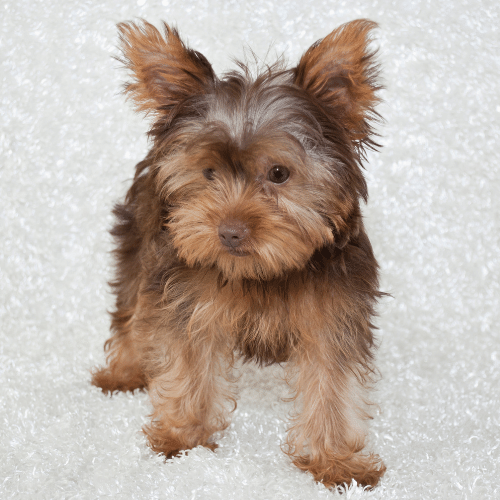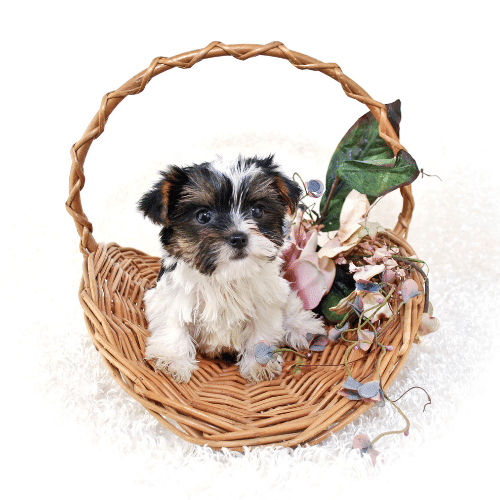Parti Yorkie Breed Profile
January 24, 2022 2022-01-24 18:30Breed Overview
Breed Type
Toy
Care Level
Medium
Size
Small
Trainability
High
Sociability & Friendliness
Intelligence
Strength
Family Dog
Physical Exercise Needs
Mental Exercise Needs
Guard Dog/Protection Instincts
Suitability For Dog Sports
Health & Longevity
Grooming Needs
Shedding
Apartment Dog
Suitable For First-Time Owners
Although it may be hard to believe it by looking at them, Parti Yorkies are purebred Yorkshire Terriers. A recessive gene is responsible for the Parti color variation, which is a tri-color or multi-color coat instead of the Yorkie’s traditional black, blue, or silver coats mixed with tan patches. These unique dogs are increasing in popularity, but they are not a breed all by themselves.
In 2000, the AKC began recognizing the Parti color variation. Both Yorkie parents must be carriers of the recessive Parti gene for the color pattern to appear in their offspring. This means two traditionally-colored Yorkies with this gene can produce Parti puppies that have patches of white, chocolate, black, and tan in their coats. After acceptance by the AKC, a huge increase in breeders producing Parti Yorkies was seen.
The coloring is the only difference between Parti Yorkies and traditional Yorkies. Before people understood this, dogs with Parti coloring were not bred further and some were even put down after being deemed undesirable. Two Yorkie breeders, Gloria Lipman and Loryn Bogren, decided to take matters into their own hands.
They reached out to other breeders and conducted DNA testing on 42 litters of Yorkie puppies. After determining the genetic makeup of Parti Yorkies was the same as Yorkies, the AKC accepted that
Today, these colorful, loving little dogs are getting the recognition and affection they deserve.
Table of Contents

Appearance
Parti Yorkies are similar to Yorkies in size and appearance aside from coat coloring. They weigh between 4 – 7 pounds and stand between 7 – 8 inches tall (making them larger than their cousins, the Teacup Yorkies).
They have long, soft coats that come in various color combinations.
There is no true standard for Parti coloring, but sometimes the coats follow certain patterns. Other times, the coats just have different patches of colors that don’t resemble a Yorkie’s normal coloring.
Golden Parti Yorkies do not have any black or dark blue coloring. Their coats can be solid gold or have hues of deep gold and light blonde.
Chocolate Parti Yorkies are brown where the traditional Yorkie is mostly black. They have chocolate, tan, and brown coloring throughout their coats. Chocolate Parti Yorkies are rare and appear to be the result of a Yorkie parent who carries a double recessive chocolate gene.
Other color combinations for Parti Yorkies include white, black, and tan, silver and black, or variations of the two.
The AKC requires Yorkshire Terriers have docked tails if they are going to meet the breed standard or be professionally shown. This applies to Party Yorkies, as well. The docking is performed when the puppies are newborns, usually between 2 – 5 days old. It’s performed mostly for aesthetic purposes and does not have to be done in order for you to own one of these dogs.

History
The first documented mentions of tri-colored Yorkshire Terriers are in books from the 1800s. Ernest Hemingway mentioned his grandfather’s pure white Yorkie named Tassel in one of his books.
While Yorkies were historically used as rodent hunters, not many dogs were spayed and neutered. This meant that females could get pregnant by dogs of other breeds. Yorkies were also bred with Maltese dogs to improve the Yorkie’s coat length and appearance. While it can’t be proven where the gene for the Parti coloring came from, there are a few different theories.
When Parti Yorkies originally started appearing in litters of two traditionally-colored Yorkies, they were thought to be low-quality dogs who weren’t purebred. Breeders didn’t want to be associated with producing these dogs, and they were often euthanized or given away quietly to avoid anyone finding out where they came from.
It’s impossible to tell which Yorkie is carrying the Party gene, and it can lie dormant until two dogs with the gene breed together.
Now that Parti Yorkies are accepted, when they show up in litters today, they are no longer considered to be intruders.
Personality and temperament
Parti Yorkies are energetic and affectionate little dogs who love to spend time with their families. They may be small, but their bark will certainly let you know when a stranger is approaching the house. They make great companions and are protective of their owners.
Parti Yorkies can get along with other pets in the house, especially if they are raised with them from the time they’re puppies. They can be scared of larger dogs and get along with with other small breeds like Shorkies or Teacup Shih Tzus . When introducing a new pet to the household, they may be aggressive and territorial.
These dogs are good with children but would be best suited for older children due to their size. They can also snap if they are accidentally stepped on or startled, so young toddlers might not be the best playmates for them.
This is a sweet dog who will enjoy a walk in the park as much as a nap on the couch with you. As true lap dogs, they like to be around their people. If they have too much alone time, they can be prone to separation anxiety. These dogs thrive when they are interacting with their owners.
Training and exercise needs of a Parti Yorkie
The Parti Yorkie is a small dog, but they still require exercise every day. One or two good walks a day will be good for them. Keeping the walks to 20-25 minutes will give your dog the mental and physical stimulation they need. A morning and evening walk would be best each day.
Parti Yorkies can also chase balls and toys to get their cardio workout. This can be done in the house if you can’t go outside. Thanks to their small size, they can run just about anywhere. They don’t require strenuous activity, but a short game of fetch and a nice walk will be enough to keep them happy.
Parti Yorkies are smart dogs, but they can be incredibly difficult to housetrain. Not only do they have a small bladder, but they tend to get separation anxiety when away from their owners. Coming home to find that your dog had an accident in the house is not uncommon. Parti Yorkies can sometimes take two years before they’re potty trained. Some always have accidents no matter what. It may be easier to train them to use potty pads inside the house.
Socialization and obedience training should start when your Parti Yorkie is young. The more you expose them to from the start, the easier training will be throughout their lives. They can sometimes exhibit “small dog syndrome,” a series of behaviors that are common in small breeds.
Signs of this syndrome include:
- Whining when they want something
- Growling at people and other animals
- Aggression
- Jumping on people and furniture
- Refusing to follow commands
- Refusing to walk on a leash
- Not responding to you when you call their name
Usually, with dogs of this size, it’s easy to ignore this behavior. The dog is tiny, and if they don’t come when they’re called, you can just go pick them up. If they don’t walk on a leash, they can be carried. If they beg for food, it’s easy to just give them a small piece. This reinforces the undesired behavior.
The way to combat this is to stop giving in. Affection towards your dog is great, but coddling is not. If they learn they can get away with things that wouldn’t be accepted by a dog of a larger breed, they will not have any reason to change their way of operating.
Take your dog to training classes or work with a trainer at home to reinforce the positive behavior and discourage the negative.
Health and care
Common health issues
Like the traditional Yorkie, Parti Yorkies have a life expectancy of 12 – 15 years. Like many purebred dogs, they are genetically predisposed to several health conditions.
When choosing your Parti Yorkie puppy, always do your research on the breeder first and make sure your puppy comes with a health guarantee and the proper age-appropriate veterinary care. A responsible breeder will be sure to only breed healthy dogs whose risk for these health problems is much lower than others. By getting their dogs genetically tested before breeding, they can be sure they are producing puppies who are the healthiest they can be.
The price for a puppy may be a little more from a reputable breeder, but it will save you money in the long run in veterinary bills and medications. The breeders invest time and money into creating healthy puppies. Your payment helps offset that cost and go towards breeding healthy puppies in the future.
When you purchase a puppy from someone whose dogs had an accidental litter, a pet store where puppies may have come from a puppy mill, or a backyard breeder who just lets their dogs have puppies as a way to make money by selling them, you’re not guaranteed that the dog is healthy. Once you hand your money over, you are responsible for all the vet bills that go along with that puppy. If that litter was carelessly created, you could be purchasing a dog that needs a great amount of care.
If you’re a Parti Yorkie owner, here are some health problems to be aware of during your dog’s lifetime.

Hypoglycemia
Sugar is stored in muscle and fat in the body until it’s needed. Parti Yorkies are so small, however, that they don’t have the ability to store enough glucose in their bodies. This means if your Yorkie gets too hungry, their sugar levels could get too low, resulting in hypoglycemia. The most common causes for this condition are poor nutrition and not eating enough food.
If you notice your Parti Yorkie showing signs of hypoglycemia, such as vomiting, seizures, fast breathing, and weakness, rub honey or maple syrup on their gums right away. Then take your dog to a vet immediately.
Dental Disease
Parti Yorkies are prone to teeth issues, usually caused by a buildup of plaque and tartar. Once the teeth start to decay or become infected, this infection can spread throughout the body. It’s important to keep your Party Yorkie’s teeth clean, either by brushing or having them cleaned professionally. Staying ahead of the issue can help in the long run. Signs of dental disease are bad breath, difficulty eating, and swollen or bleeding gums.
Legg-Perthes Disease
This genetic disease affects the hip joint and femur. The femur bone begins to deteriorate, causing pain and immobility. Symptoms of this condition are inability to walk, limping, and loss of muscle mass. A diagnosis is made by using an x-ray.
This condition eventually turns into arthritis. Treatment can range from pain medication to control the symptoms to a full hip replacement surgery. Sometimes, the hip area can heal itself depending on how advanced the disease is.
Retinal Dysplasia
This genetic disease causes abnormal retinal development that can lead to a complete detachment and blindness. The condition is present from birth and can affect both eyes. You’ll notice your Party Yorkie having trouble seeing. They may be hesitant to walk down any stairs or jump off furniture.
This condition is diagnosed by an eye exam during a vet visit. With vision loss, your dog can still live a happy life. There is no treatment for this, but by memorizing the layout of the house and where the food and water dishes are, many dogs can do just fine with partial or complete vision loss.
Luxating Patella
This condition can be genetic or be caused by a knee injury. It occurs when the kneecap slides out of place instead of fitting snugly in the patellar groove. Over time, the tendons that hold the kneecap weaken causing the kneecap to move and creating pain for your dog.
You’ll notice your Parti Yorkie stretching their leg backward as they walk to try and realign their kneecap. Some dogs will also skip as they walk or carry their back leg up for a few steps.
Your vet will diagnose this through the use of an x-ray. Most minor cases involve medication for the pain and inflammation of the area. Keeping your dog at a healthy weight will also help keep them out of pain. Surgery can be required in severe cases.
Collapsed Trachea
Collapsed tracheas can be the result of an injury, like pulling hard against the collar when they walk, or they can be the result of genetics. When the trachea collapses, it becomes flattened and can be life-threatening for your dog. Symptoms include coughing, panting, difficulty breathing, and difficulty eating which sometimes results in gagging.
Medications can be prescribed to relieve inflammation, open the trachea, suppress coughing, and reduce the anxiety that goes along with this condition. Having your dog lose weight if they need to will also help.
Liver Shunt
This is a birth defect in which the puppy’s liver does not develop properly. It does not close entirely, and this doesn’t allow blood to flow through it as it should. This lowers the functionality of the liver.
When the liver is not functioning properly, it allows toxins to store in the body. Symptoms of this condition are lethargy, vomiting, and seizures. The dog’s size will also be a sign as this health issue results in small puppies who are inactive without much muscle mass.
Blood work combined with an MRI or CT scan will diagnose liver shunts. Surgery can be a good treatment option, depending on how severe the shunt is. Sometimes they can be controlled with medication.
Pancreatitis
This condition is the inflammation of the pancreas that can sometimes be caused by a diet high in fat. It occurs when the pancreas is overworked trying to produce enough digestive enzymes to digest the dog’s food.
Symptoms include diarrhea, vomiting, lethargy, lack of appetite, and stomach pain.
This condition is diagnosed with a blood test. Your dog may need to be hospitalized if the issue is severe. Fluids and antibiotics may be necessary. After your dog recovers, a low-fat diet is usually recommended.

Grooming
Parti Yorkies have beautifully colored coats, and these coats need regular grooming in order to remain healthy.
Brushing your dog is important to keep them free from mats. This should be done daily. It also removes any debris that the coat picked up.
Bathing should be done once a month, or whenever your dog is dirty. Use shampoo and conditioner that is made for dogs and be sure to rinse them thoroughly.
Trimming their coats will help keep your dog cooler in warm months and will also keep their coats from growing out of control. Parti Yorkies need regular coat maintenance. The coats can grow long and not only get messy but also block your dog’s vision.
The good news is all of this can be done at a professional grooming shop. They can trim and clean your dog’s coat and trim their nails.
Regular nail clipping should be done to avoid paw injuries from overgrown nails. If you don’t feel comfortable doing this yourself, your vet or professional groomer will be happy to.
Examine your dog’s ears for signs of infection. This includes swelling, a foul odor, your dog constantly scratching their ear, redness, or pain when you touch the ear. If you do see any evidence of an infection, contact your vet for the proper medication to clear it.
Cleaning the ears regularly will help keep dirt and wax from building up. You can do this with cotton balls and an ear cleaning solution, or ask your groomer to clean the ears during your dog’s appointment.
Adopting a Parti Yorkie
Because the Parti Yorkie is the result of a recessive gene, it may be harder to find them than traditional Yorkies. Checking with Yorkie breeders is a good way to see if any Parti puppies are available since they can show up randomly in litters.
Some breeders specifically breed Parti Yorkies but they may not be available in all areas.
Always make sure the breeder you choose is responsible. They shouldn’t constantly have puppies available. It’s normal to have to wait for a litter to be born. The breeder should be able to answer any questions you have and allow you to visit their property to see the dogs. Ask to see the parent dogs. Look for any signs of illness in the dogs, such as coughing, runny noses and eyes, lethargy, and skin lesions.
Your Parti Yorkie puppy should come with their first round of puppy vaccines and deworming. Most breeders charge between $2,000 – $4,500 for a puppy. Making sure you are getting a healthy puppy is the important part. The high price tag may mean less money down the road in trying to treat or cure your dog’s health conditions.
Yorkie rescues may have Parti Yorkies available, and this cost will be considerably less than a breeder. You’re saving a life and paying an adoption fee that goes to help the rescue. This fee is usually between $150 – $300 and will include the dog’s vetting, microchip, and spay/neuter surgery. You may be getting an older dog, but you will be saving considerably in upfront costs.
Experience level for owning a Parti Yorkie
Parti Yorkies are fun and happy dogs who make wonderful companions for families, but they can be difficult to train. Patience is necessary for the first few years of the dog’s life while you work on housetraining and obedience.
Some Parti Yorkies will have different personalities than others, and some dogs may be very easy to train while others are impossible. This depends on the individual dog. It’s a broad generalization to say all Parti Yorkies are difficult to train, but it’s an important thing to consider if you’re looking to add this dog to your home.
Housetraining can often take years and in some cases, never be done perfectly at all. In this case, potty pads in the house may work well. Parti Yorkies have tiny bladders and it may be impossible to take them outside every time they have to go.
These are smart dogs who can learn commands and tricks through the right training methods. Patience and consistency are required along with positive reinforcement.
A Parti Yorkie can be a good choice for a first-time dog owner if you understand what you’re getting into. This dog can try to be dominant and assertive, refusing to listen and doing whatever they choose instead. Improper training methods will cause this issue to get worse, not better. If you have the patience and desire to build a healthy relationship with your dog, this is one that will be highly rewarding.
Experienced dog owners can add a Party Yorkie to their household with relative ease. They know what this dog will try to get away with and can put the proper techniques in place to train them and show them the appropriate ways to behave.
The bottom line
Parti Yorkies are Yorkies in every way except the coloring. What you’re getting with this dog is a fun-loving, affectionate, happy dog who will enjoy being the boss of you if you allow it. They can be strong-willed and temperamental, so bringing this dog into your home requires commitment.
This dog doesn’t require much exercise and is happy with a couple of walks a day or chasing a ball around the house or yard.
If you do your research on a responsible breeder, you can purchase a puppy who has less of a risk of suffering from the genetic health problems Yorkshire Terriers tend to have. Don’t be afraid to ask your breeder questions or shop around if you’re not comfortable with the answers they provide.
While the Parti Yorkie has grooming needs thanks to their long coats, a professional groomer can help with this. Keeping up with their grooming and dental care can prevent problems in the future and keep your dog comfortable and happy.
If you’re ready to put in the work for this dog, you will receive lots of love, devotion, and affection in return. Being prepared before you bring your puppy home will help the transition go smoothly. Don’t forget that training and socialization can start right away so you can have a happy, healthy dog.

Author: Jessica Rossetti
Jessica lives in Chicago with her husband, Dominic, and their rescued cat, Toast. She has lived with dogs for over 30 years and spends her days writing, caring for various animals, and enjoying her backyard that has become an oasis for wild creatures.
Her passion for animals began at a young age when she would bring home the lost dog or cat. As she got older, she went on to bring home an injured bird or raccoon. This love and desire to help all creatures led to her work as an adult with various animal rescues, where she saved the lives of many domestic and wild animals while learning the necessary skills to care for them.
Owning and operating a professional pet care service in Chicago for the past twelve years, Jessica cares for dogs in her home while writing full-time.

